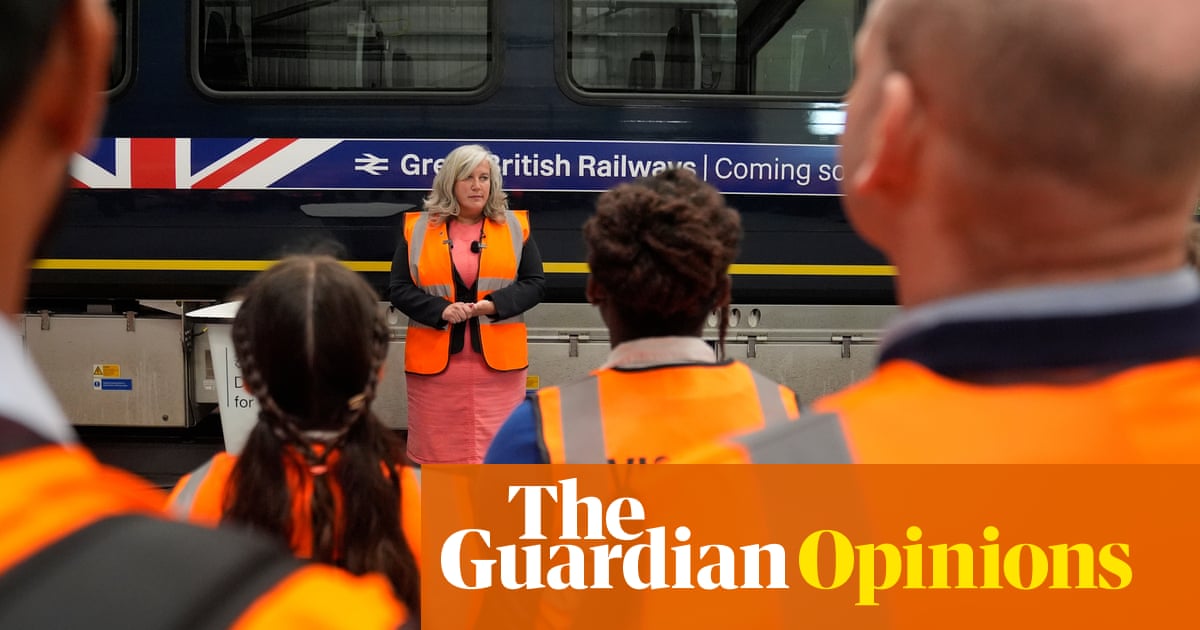Ahistoric journey took place this week, when the first renationalised South Western Railway (SWR) service departed from Woking for Waterloo. Yet unfortunately, passengers had to disembark at Surbiton andboard a rail replacement busas a result of engineering work.
The incident highlights that this is a moment of maximum vulnerability in the push for greater nationalisation in Britain. SWR is the first train company to be nationalised under this Labour government, which has plans to renationalise nearly all services in Englandby 2027. But at the launch, the transport secretary, Heidi Alexander, said shecouldn’t promisethat nationalisation would yield lower fares. If services don’t improve and fares don’t fall, critics will have their attack line ready: “We told you nationalisation doesn’t work – just look at the trains.”
It is critical that public ownership is seen to deliver better value for money, lead to reinvestment to improve services and genuinely meet the transportation needs of communities across Britain. Success or failure will shape attitudes towards it for years to come. Success could build momentum for bringing other essential services under democratic control. Failure will provide ammunition for privatisation advocates across every sector.
The case for change is overwhelming. Since privatisation, rail fares haverisen by a fifthin real terms, while analysis by the thinktank Common Wealth in 2023 found UK passengers payfive timesas much per kilometre as those in France, where rail is publicly owned. Overall, privatised rail costs taxpayers£1bn more annuallythan public ownership would. This is extraction, not efficiency.
Between 2006 and 2022, anestimated 65%of train operating company profits were paid out in dividends to shareholders, while passengers endured cancelled services and eye-watering fare increases. Our railways have become engines of profit for investors and overseas state enterprises, with the Italian, French and Hong Kong governments owning major franchises alongside global asset managers such as BlackRock. Labour’s approach must address three critical challenges to ensure that nationalisation delivers tangible benefits rather than disappointment.
First, the government must not stop at train operators. In 2022-23, the rolling stock companies, which lease trains and carriages to operators, saw theirprofits treble, with more than £400m paid to shareholders and profit margins rising to a whopping 41.6%. As the RMT union found,87% of Britain’s rolling stockis controlled by just three companies. Without nationalising rolling stock companies as well, train operating companies being brought into public ownership will continue to be beholden to enormous lease payments to private companies, as we saw between 2016 and 2024, when such paymentsrose by 78%in real terms (compared with staff costs, which attract much more controversy but only rose by 11%). These firms are extracting enormous profits while the public sector bears the risk. Nationalisation should mean bringing the entire system under democratic control, including the trains.
Second, passengers must feel real benefits quickly. Travellers boarding these trains will not initially notice any difference, because the changes that matter – reinvestment rather than extraction, service improvements over dividend payments – will take time to materialise. Meanwhile, any delays, cancellations or fare increases will be attributed to public ownership, regardless of their actual cause. Plans forautomatic refundsfor late trains are a start, but change for commuters must not end there. The new public operator should freeze fares immediately and introduce simplified, integrated ticketing across the network. Revenue that previously flowed to shareholders should fund service improvements – more staff, better cleaning and extended opening hours at stations. Visible changes will build public support for broader transformations.
Third, the government cannot simply replace private managers with civil servants. This means recruiting rail professionals and devolving decision-making to regional teams, rather than centralising everything in London. Most importantly, it means embedding passenger representation and worker participation from day one.
There are signs thatLabourunderstands the scale of the challenge. The party has committed to establishing Great British Railways as an integrated public body, moving beyond the fragmented structure that has plagued the network since privatisation. But integration on paper is not enough. It must translate into coordinated investment, simplified passenger experience and democratic accountability. Only when the entire system operates under public control can passengers fairly judge its performance.
Labour’s rail nationalisation represents more than transport policy – it’s a test case for 21st-century public ownership. For this to succeed, passengers must pay less for better services, workers must have a voice in their future and communities must benefit from integrated planning rather than fragmented profit maximisation.
As Common Wealth’sresearch has shown, the economic case for rail nationalisation is clear. Now comes the harder task of making it work in practice. This requires courage to challenge vested interests, operational expertise to improve services and democratic innovation to ensure public ownership serves the public.
If nationalised operators deliver visible improvements while keeping costs under control, public support will grow and opposition critique will ring hollow. But if it is business as usual with a different logo, we’ll have squandered a once-in-a-generation opportunity to prove that public ownership works.
The prize is enormous: affordable, reliable rail transport that serves communities rather than shareholders. The risk is equally significant: discrediting public ownership for years to come. Labour must get this right.
Sarah Nankivell is deputy director of Common Wealth
